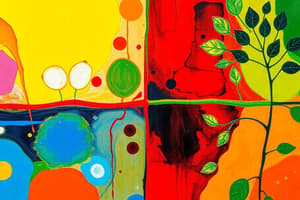Podcast
Questions and Answers
What is the primary purpose of photosynthesis?
What is the primary purpose of photosynthesis?
- To fix carbon dioxide from the atmosphere
- To convert light energy into chemical energy (correct)
- To convert glucose into ATP
- To release oxygen as a waste product
Which molecule acts as the primary energy carrier produced during cellular respiration?
Which molecule acts as the primary energy carrier produced during cellular respiration?
- ATP (correct)
- Glucose
- NADPH
- RuBP
What is the main output of the Calvin Cycle?
What is the main output of the Calvin Cycle?
- Glucose
- Oxygen
- NADPH
- G3P (correct)
Where do the light-dependent reactions take place in a plant cell?
Where do the light-dependent reactions take place in a plant cell?
Which of the following is a key step in the process of carbon fixation during the Calvin Cycle?
Which of the following is a key step in the process of carbon fixation during the Calvin Cycle?
What byproduct is released during the light-dependent reactions?
What byproduct is released during the light-dependent reactions?
How does the Calvin Cycle utilize ATP and NADPH?
How does the Calvin Cycle utilize ATP and NADPH?
What initiates the process of photolysis in light-dependent reactions?
What initiates the process of photolysis in light-dependent reactions?
What was the primary goal of the Lahore Resolution of 1940?
What was the primary goal of the Lahore Resolution of 1940?
How did the Two Nations Theory affect the socioeconomic status of Muslims in India?
How did the Two Nations Theory affect the socioeconomic status of Muslims in India?
In what way does the Two Nations Theory influence cultural identity in Pakistan?
In what way does the Two Nations Theory influence cultural identity in Pakistan?
What contemporary issues does the Two Nations Theory influence in South Asia?
What contemporary issues does the Two Nations Theory influence in South Asia?
What was a significant post-independence challenge faced by Pakistan as a result of the Two Nations Theory?
What was a significant post-independence challenge faced by Pakistan as a result of the Two Nations Theory?
Flashcards are hidden until you start studying
Study Notes
Photosynthesis and Cellular Respiration
-
Photosynthesis: Process by which green plants, algae, and some bacteria convert light energy into chemical energy (glucose).
- Occurs primarily in the chloroplasts.
- Overall equation: 6CO₂ + 6H₂O + light energy → C₆H₁₂O₆ + 6O₂.
-
Cellular Respiration: Process by which organisms convert glucose into usable energy (ATP).
- Occurs in mitochondria.
- Overall equation: C₆H₁₂O₆ + 6O₂ → 6CO₂ + 6H₂O + ATP.
-
Relationship:
- The products of photosynthesis (glucose and oxygen) are reactants for cellular respiration, and vice versa.
- Represents a cycle of energy transformation in ecosystems.
Calvin Cycle
-
Location: Occurs in the stroma of chloroplasts.
-
Purpose: Fixes carbon dioxide to synthesize glucose during the light-independent reactions.
-
Key Steps:
- Carbon Fixation: CO₂ is captured by ribulose bisphosphate (RuBP), catalyzed by ribulose bisphosphate carboxylase/oxygenase (RuBisCO).
- Reduction Phase: ATP and NADPH (from light-dependent reactions) convert 3-phosphoglycerate (3-PGA) into glyceraldehyde-3-phosphate (G3P).
- Regeneration of RuBP: Using ATP, some G3P is converted back to RuBP to continue the cycle.
-
Output: Produces G3P, which can be further converted into glucose and other carbohydrates.
Light-dependent Reactions
-
Location: Occur in the thylakoid membranes of chloroplasts.
-
Purpose: Convert light energy into chemical energy (ATP and NADPH) and release oxygen.
-
Key Steps:
- Photon Absorption: Light energy excites electrons in chlorophyll molecules.
- Water Splitting (Photolysis): Water molecules are split to release O₂, electrons, and protons.
- Electron Transport Chain (ETC): Excited electrons move through a series of proteins, creating a proton gradient across the thylakoid membrane.
- ATP Synthesis: Protons flow back across the membrane through ATP synthase, producing ATP.
- NADPH Formation: Electrons reduce NADP⁺ to NADPH.
-
Products: ATP, NADPH, and O₂ (as a byproduct).
Historical Background
- Muhammad Ali Jinnah, the founder of Pakistan, articulated the Two Nations Theory in the early 20th century.
- The theory argues that Muslims and Hindus in India are distinct nations due to their differing religions, cultures, and social customs.
- The Lahore Resolution of 1940 called for the establishment of independent states for Muslims in northwestern and eastern India.
Socioeconomic Implications
- There were significant economic disparities between Hindus and Muslims in India, with Muslims facing marginalization.
- The Two Nations Theory promoted the idea of a separate Muslim state to ensure economic development and opportunities for Muslims.
- Pakistan faced economic challenges after independence, including distributing resources and balancing regional interests.
Cultural Identity
- The Two Nations Theory emphasizes the distinct cultural identity of Muslims, rooted in shared religion and traditions.
- It fostered a sense of unity among Muslims and contributed to a collective identity defined by religion.
- Cultural expressions, art, and literature in Pakistan reflect Islamic values, showcasing a specific cultural status.
Contemporary Relevance
- The Two Nations Theory remains influential in shaping Pakistani national identity and politics, impacting narratives around nationalism and religion.
- The theory continues to be discussed in relation to sectarian divides and inter-communal relations within South Asia.
- The Two Nations Theory is referenced in contemporary India during debates over secularism, nationalism, and minority rights.
Studying That Suits You
Use AI to generate personalized quizzes and flashcards to suit your learning preferences.




